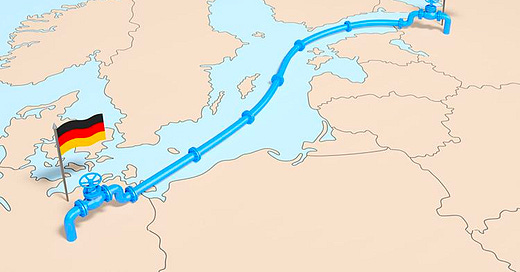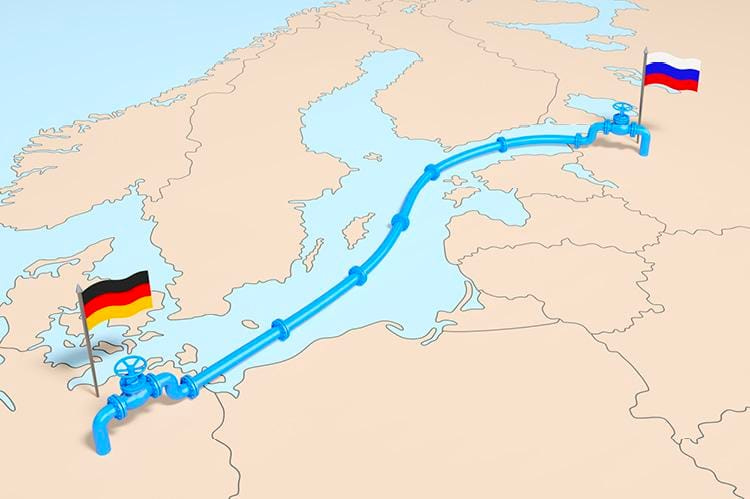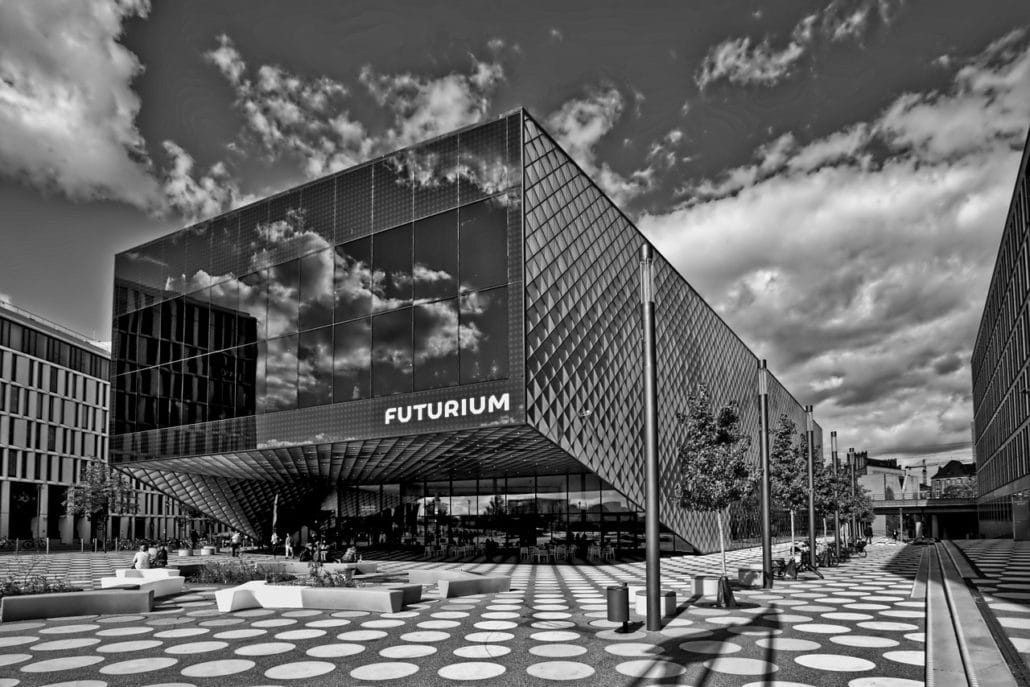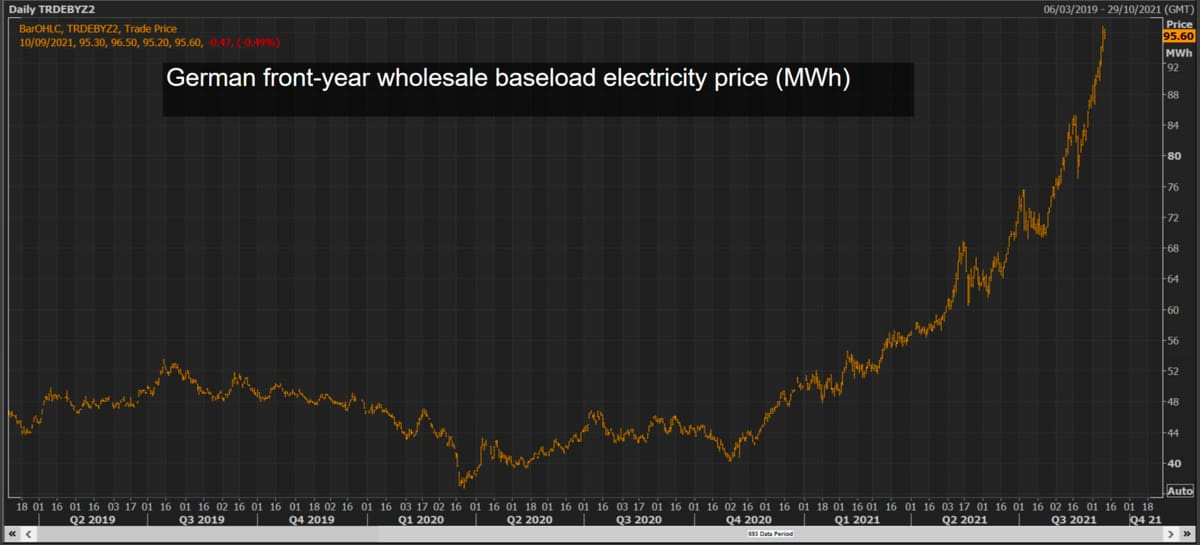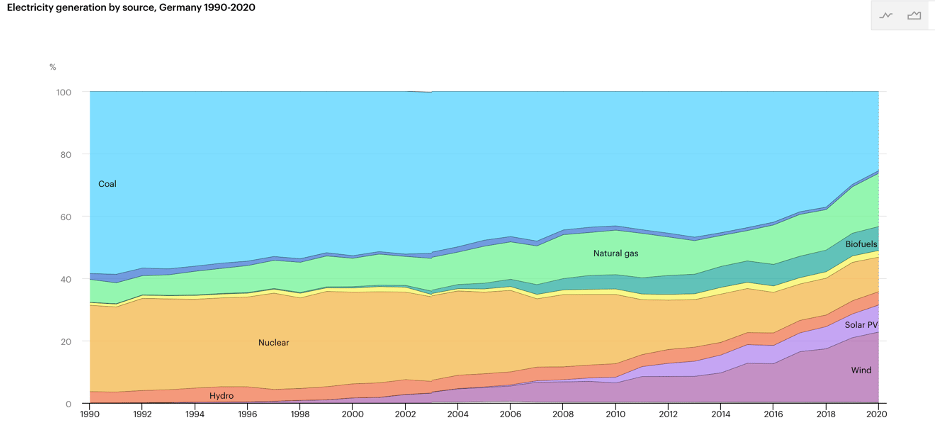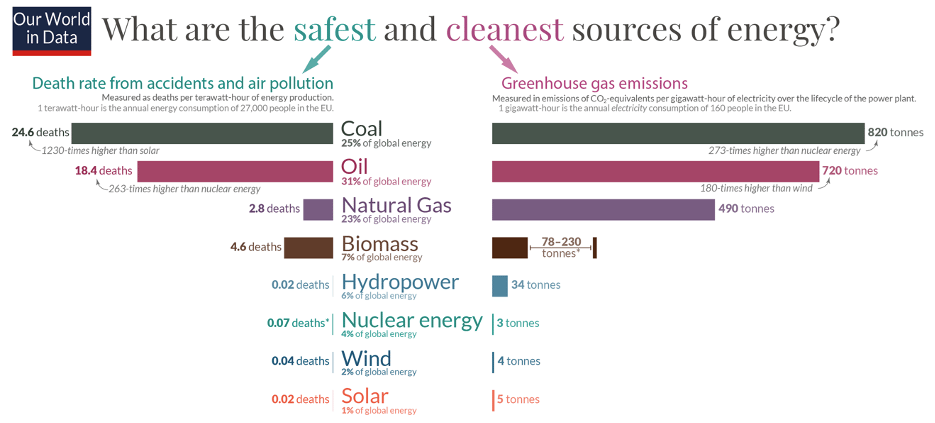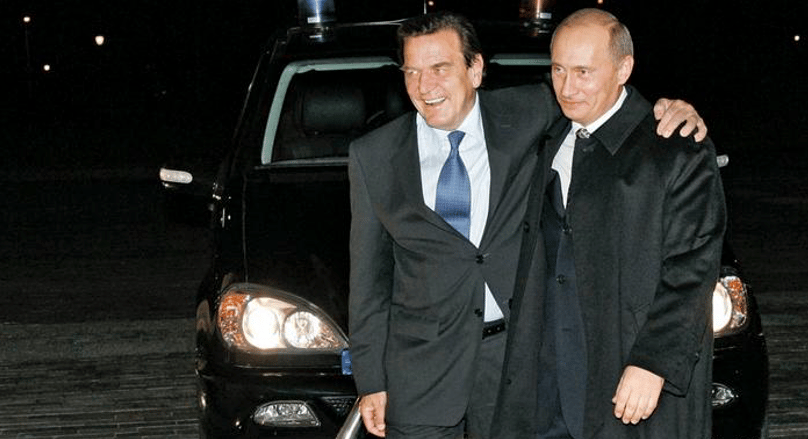Welcome to Young Money! If you’re new here, you can join the tens of thousands of subscribers receiving my essays each week by adding your email below.
I took a different angle with today's piece. I'm sure that you all have noticed the uptick in gas prices here in the US, but that is nothing compared to what is going on in the German energy markets right now. In the wake of the Russia-Ukraine conflict, German electricity prices are through the roof because of their heavy reliance on Russian gas. I decided to investigate why Germany became so dependent on Russia in the first place.
The reason is interesting, to say the least. I hope you guys enjoy today's piece 🤝
"You have stolen my dreams and my childhood with your empty words. And yet I'm one of the lucky ones. People are suffering. People are dying. Entire ecosystems are collapsing. We are in the beginning of a mass extinction, and all you can talk about is money and fairy tales of eternal economic growth. How dare you!
…You are failing us. But the young people are starting to understand your betrayal. The eyes of all future generations are upon you. And if you choose to fail us, I say: We will never forgive you.
We will not let you get away with this. Right here, right now is where we draw the line. The world is waking up. And change is coming, whether you like it or not.”
– 16-year-old Greta Thunberg at the U.N.’s Climate Action Summit, 2019
*slow claps*
Climate change. The existential crisis that has filled every Gen-Zer with dread since they entered grade school. Politicians, CEOs, and other powerful figures fly their private jets to summits around the world each year to condemn the fossil fuel industry as a vile plague that must be destroyed at all costs.
To raise awareness about the climate issue, green technology exhibits have popped up in museums around the world. One such museum is the Futurium, located less than a mile from the Reichstag in Berlin, Germany.
While backpacking across Europe last year, I spent 10 days in Berlin. After seeing an advertisement at my hostel for the Futurium, I decided to pay the museum a visit.
While walking around this exhibit, and I saw all sorts of futuristic examples of climate technology. Green cities with gardens and forests growing on the roofs of skyscrapers. Windmills and solar panels supporting power grids. A future powered by zero-emission, renewable resources. It was certainly a pleasant vision.
But there was one glaring omission from this exhibit on clean energy: nuclear power.
I stepped aside to ask one of the museum’s curators if they had a nuclear energy section of the green exhibit.
“I’m sorry to say that we don’t. This exhibit is meant to highlight Germany’s safe, sustainable green future.”
“Oh really? That’s interesting bec-,” I bit my tongue. “Ah, okay thanks. I was just curious.”
Back at the hostel that night, I couldn’t stop thinking about the feasibility of the whole thing. Sure, this green future sounded good. A world powered by sunlight and wind power, with no smog or pollution. Green cities with no carbon footprints.
It matched the utopic vision that had been forced on me since I was a kid: if we drop fossil fuels tomorrow, the world becomes a better place.
The thing is, reality doesn’t give a damn about what ‘could be’ and what ‘should be’.
Reality doesn’t give a damn about utopia.
Reality is reality.
What happens when policy makers sacrifice reality for utopia?
The above chart was from September, when supply chain disruptions wreaked havoc on energy prices.
Now let’s fast forward a few months. In the wake of a brutal winter, Russia decided to invade Ukraine, and German gas and power prices have soared to new highs. A household using 20,000 kWh per year agreeing to a new annual contract in March had to pay a record $3,632, up 62% from just three months ago.
Solar panels and windmills sound great when times are good, energy prices are low, and there’s not a care in the world. However, I can assure you of one thing: when winter sets in, supply chains are wrecked, and war is waging in eastern Europe…
a climate crisis is the least of your worries, and tears at a UN podium aren’t going to keep your family warm.
So how did Germany get here? Where did Europe’s most innovative nation drop the ball?
Let’s go back to the 1950s.
The Nuclear Dilemma
German nuclear power began with the construction of research reactors in the 1950s and 1960s, and the first commercial plant came online in 1969. However, the anti-nuclear movement is nearly as old as the reactors themselves. As early as 1964, critics claimed that the “dangers and costs of the necessary final disposal of nuclear waste could possibly make it necessary to forego the development of nuclear energy.”
As nuclear adoption increased in the 1970s, thousands of protestors would gather at proposed sites for new plants around the country. After the partial meltdown of a US reactor at Three Mile Island in 1979, 200,000 Germans took to the streets in Hannover and Bonn to demonstrate against the use of nuclear power. That being said, the anti-nuclear movement remained largely sporadic and unorganized until 1980.
On January 13, 1980, a new political party, The Greens, was founded in the central European nation. The Greens emerged from a wave of new social movements including environmentalism, anti-war, and anti-nuclear power. Suddenly, the anti-nuclear movement had a face.
Since the party’s inception, The Greens have been concerned with the immediate halt of construction and operation of all nuclear power stations. As an alternative, they have promoted a shift to non-nuclear renewable energy sources such as solar and wind power.
In 1986, large parts of Germany were covered with radioactive contamination from the Chernobyl disaster, sparking widespread hysteria. Anti-nuclear protests broke out across the country, and the Green Party called for “the immediate shut-down of all nuclear facilities.” Support for this new party grew in the wake of Chernobyl, and The Greens increased their share of the vote to 8.3% in the 1987 federal election.
Unlike the US, where we have a two-party system, the German legislature is a multi-party system. In 2021, for example, seven parties controlled at least 5% of the parliament’s voting power and seats. Given this structure, The Greens’ 8% voting share in 1987 was significant.
After the Chernobyl disaster, the Greens became more radicalized and refused to compromise on the nuclear issue. Fearing public backlash, politicians across all parties began to stress that nuclear was a “transient technology”, but not the future. After 1989, no new commercial nuclear power plants were built in Germany.
In 1998, the Social Democratic Party of Germany (SPD) and the Greens led the nation as a joint coalition. Gerhard Schröder, leader of the SPD, was elected as Chancellor.
In his first term, Schröder’s government decided to phase out nuclear power and instead double down on funding renewable energies. This phase out plan, known as the “nuclear consensus”, limited the lifespan of all nuclear plants to 32 years. Each plant was allocated an amount of electricity that it could produce before being shut down, with the end goal being the shutdown of all nuclear plants by 2022.
The results after 20 years?
Germany has certainly succeeded in cutting back its nuclear power production. However, it is far from a green utopia. The chart below from the IEA shows Germany’s electricity generation by source from 1990 to 2020:
If colors aren’t your thing, I broke the data down into percentages below. Nuclear is highlighted.
Color me shocked, I mean shocked, to see that the face of the green movement gets most of its electricity from… coal. It turns out that coal isn’t the most environmentally friendly fuel source either! It’s actually 273x more harmful than nuclear power.
This reliance on coal will be important in a bit.
Fascinating stuff, no?
Now to Germany’s credit, they have done an excellent job of expanding their wind and solar power, growing them from less than 1% of electricity generation in 2000 to more than 31% in 2020. But that doesn’t answer the question:
Why the reduction in nuclear power?
According to Our World in Data, nuclear is the cleanest form of energy available. It is also 351x safer than coal, with only a rounding error separating it from wind and solar (and this includes Chernobyl and Fukushima).
The shift away from nuclear has little to do with the dangers of nuclear reactors, nor the viability of other renewable energy sources.
It has a lot to do with natural gas.
Gas Me Up
Notice that natural gas jumped from 9% to 17% of German electricity generation since 2000. While Germany was busy cutting its nuclear production, alternative forms of renewable energy couldn’t fill total output deficit left behind.
Gas still produces 150x more emissions than nuclear, but it is cleaner than coal and oil. Having already committed to phasing out nuclear, Germany turned to natural gas to fulfill its energy needs. There was just one problem:
Germany produces little natural gas of its own.
However, Europe’s estranged neighbor to the east, Russia, happens to produce the second-most most natural gas in the world.
So Germany bumped up its Russian imports. How much gas does Germany import from Russia?
A lot.
Germany’s economy and climate ministry said that in 2022, 55% of its gas imports came from Russia, 30% from Norway, and 13% from the Netherlands.
Part of the reason that Germany is so reliant on Russian gas is that it doesn’t have its own liquified natural gas (LNG) import terminals, meaning that all of its gas has to come through pipelines.
The Nord Stream 1 pipeline, owned and operated by Russian gas giant Gazprom, can transport up to 55B cubic meters of gas to Germany each year, and the recently completed Nord Stream 2 pipeline would have doubled this capacity. However, in response to Russia’s invasion of Ukraine, Germany put the certification of Nord Stream 2 on hold.
German has now made plans to build two domestic import terminals to reduce energy dependence on Russia in the future, but that does little to fix the supply crunch that the country is facing now.
To recap: Germany shut down nuclear power, the cleanest form of energy available, and planned to replace it with other renewable energy sources. When demand couldn’t be satisfied by renewable energy alone, it turned to natural gas, a much dirtier form of energy. Germany doesn’t have import terminals for LNG, making it dependent on pipelines.
Russia has the highest capacity pipeline network to Germany, making it Germany’s main suitor.
Cool.
Now let’s bake another layer into Germany’s energy problem.
While Germany has reduced its dependence on coal by 50% since 2000, coal is still its primary source of electricity.
There are two kinds of coal used for energy: hard coal and brown coal. Hard coal is notoriously bad for the environment, and Germany has ended all domestic mining of this product. However, while 16.9% of Germany’s electricity is generated from the “cleaner” brown coil, 7.4% of the country’s grid is still powered by hard coal. A product that it no longer produces domestically.
So Germany now imports 100% of its hard coal, which is responsible for 7.4% of its electricity.
And who does Germany import 45% of its hard coal from?
Russia.
Starting to notice a theme here?
So this central European country, that is “leading the charge” against climate change, has terminated its greenest energy source. Germany is now reliant on Russia, a country that doesn’t give a damn about climate change, for two of its main power sources, which both happen to be terrible for the environment.
Surprisingly, there wasn’t much information about this at that Futurium exhibit!
There Are No Coincidences
This must have been a miscalculation, right? Germany must have underestimated how long it would take to implement other renewable energy sources. They underestimated what their energy needs would be in 20 years. Maybe they falsely thought that coal was cleaner than nuclear power!
Maybe, but probably not.
Let’s circle back to Germany’s Chancellor in year 2000. Since 2017, Gerhard Schröder, the man who led the charge to shut down nuclear in the name of renewable energy, has been the chairman of Russian energy company Rosneft.
In February 2022, just weeks before Russia invaded Ukraine, Schröder, the man who led the charge to shut down nuclear in the name of renewable energy, was named to the board of Gazprom, the Russian state-owned multinational energy corporation that did $120B of revenue in 2019. You know, the same Gazprom that owns the Nord Stream Pipelines.
Schröder also happened to be the man who authorized construction of this very Nord Stream Pipeline in 2005!
It really shouldn’t be a surprise that Schröder has found himself in such an enviable position in the Russian energy industry. After all, he is a long-time friend of Russian president Vladimir Putin, spending several birthdays in St. Petersburg and Moscow.
Best friends ❤️
Germany, the most powerful country in the EU, is now at the mercy of Russian energy policy. Guess what product has been conveniently left out of sanctions against Russia in response to its invasion of Ukraine?
Energy.
There are no coincidences.
We knew back in 2014 that Russia was willing to influence foreign energy policy. Anders Fogh Rasmussen, then secretary-general of NATO, stated that he had reliable information that Russia was engaged with British environmental organizations working against shale gas. The UK proceeded to ban fracking in 2019.
Why would Putin be anti-shale? Was he worried about the environmental impact of fracking? No.
He wanted Europe to remain reliant on Russian gas.
Best Story Wins
It is the most ironic plot line, no?
Russia, a country seemingly stuck in the 1980s era of pollution-heavy industrialization, was actively funding green movements in the United Kingdom. Schröder, the German chancellor who led the “green movement” in his country, who is both best friends with Putin and a board member on multiple Russian energy companies, played an integral role in building the pipeline network from Russia to Germany.
Oh the irony.
This happened because we humans aren’t moved by data, statistics, and probabilities. We are compelled by stories.
I could show you data that zero Germans were adversely affected by the Chernobyl meltdown. I could prove to you that the radiation received from touring the Chernobyl zone is less than what a passenger receives on a NYC to London flight.
Or I could bombard you with misinformation about radioactive waste, terrify you with stories of nuclear malfunction, and sow seeds of doubt into the mind of the general populace, “What if Fukushima happens here?”
I could show you evidence that solar and wind power can’t generate enough power to fuel the world’s biggest economies, or I could extrapolate temperature “data” to forecast that climate change will destroy the world if we don’t shut down fossil fuels now.
Data is no match for powerful stories.
Stories tug at our emotions. Fear of nuclear fallout and global warming-induced existential threats, no matter how far-fetched, dominate public opinion.
Stories are the reason that Americans are terrified of plane crashes, an event that happens 1 out of every 16 million flights, but we don’t think for a second about heart disease, a condition that kills 1 out of every 4 of us.
Stories spread like wildfire, creating protests and demonstrations. The strongest stories make their way into parliaments and congresses around the world, warping public policy, data be damned.
Stories helped the Green Party outlaw nuclear energy in Germany, despite it being the safest and cleanest form of energy in the world.
Stories led Western European nations to sacrifice energy independence now, to guard against a vague potential threat at some point in the future.
Stories made Russia, the silent enemy of the west for fifty years, Europe’s primary energy provider.
Putin and company quietly mastered the art of storytelling by using the green energy narrative to increase foreign dependency on Russian gas:
Make sure everyone is the world views climate change as a threat, vilify western oil and gas companies, encourage legislation that favors renewable energy, amplify unfounded fears about nuclear power, and profit as countries quietly realize that they need natural gas to keep the lights on.
The green movement was, ironically, the most efficient way for Putin and Schröder to pad their pockets at Europe’s expense.
But you know what, maybe it would be worth it if it made a difference. Maybe sacrificing energy independence would be a fair trade off if it made the world a cleaner place.
But it didn’t. If anything, western energy policy managed to make the world a dirtier place.
While western leaders pat themselves on the back for “doing their part”, for shutting down fossil fuel plants and nuclear reactors, for building windmills and solar farms, they don’t realize that they didn’t change a damn thing.
The planet isn’t greener, because the pollution didn’t go away. It was simply outsourced with energy independence.
Germany and England replaced nuclear reactors and domestic shale with Russian gas, and I doubt Putin is losing sleep over his carbon footprint. Believe it or not, the ozone layer doesn’t discriminate by geography, and outsourced fossil fuels are, in fact, still fossil fuels.
The greatest two lies that the green movement ever told were that we could drop fossil fuels for renewables overnight, and nuclear didn’t need to be part of the solution.
But these two lies have proven to be quite lucrative for certain Russian energy companies.
Who knew that Vladimir Putin was renewable energy’s biggest cheerleader?
- Jack
I appreciate reader feedback, so if you enjoyed today’s piece, let me know with a like or comment at the bottom of this page!
Young Money is now an ad-free, reader-supported publication. This structure has created a better experience for both the reader and the writer, and it allows me to focus on producing good work instead of managing ad placements. In addition to helping support my newsletter, paid subscribers get access to additional content, including Q&As, book reviews, and more. If you’re a long-time reader who would like to further support Young Money, you can do so by clicking below. Thanks!

